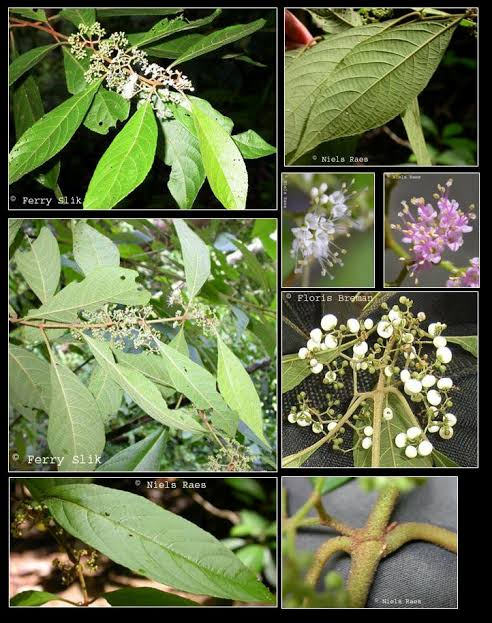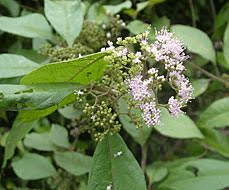Callicarpa longifolia, commonly known as Himalayan Beautyberry, is a remarkable medicinal plant with a rich history of traditional use. Native to the Himalayan region and parts of Southeast Asia, this plant has been treasured for its various health benefits for centuries.
The Botanical Description of Callicarpa longifolia
1. Life: Callicarpa longifolia is a deciduous shrub, which means it sheds its leaves annually. It belongs to the family Lamiaceae and is characterized by its slender, upright growth habit.
2. Appearance: The shrub typically reaches a height of 6 to 12 feet (1.8 to 3.6 meters). It features simple, elliptical leaves with a glossy texture. The leaves are dark green on top and paler underneath.
3. Flowers: Callicarpa longifolia produces small, tubular, lavender to pinkish flowers in clusters, making them visually appealing.
4. Berries: The most distinctive feature of the Himalayan Beautyberry is its bright purple to violet-colored berries. These berries grow in dense clusters along the stems and are a prominent ornamental feature.
5. Habitat: Callicarpa longifolia is native to the Himalayan region, including India, Bhutan, and Nepal. It thrives in subtropical and temperate climates.
6. Cultivation: Gardeners and horticulturists appreciate Callicarpa longifolia for its ornamental value. It is relatively low-maintenance and can be cultivated in well-drained soil and partial sunlight.
7. Traditional Uses: Throughout its native range, Callicarpa longifolia has been used in traditional medicine for various health purposes, owing to its medicinal properties.
The Geographic Distribution of Callicarpa longifolia
Callicarpa longifolia, or Himalayan Beautyberry, has a specific geographic distribution that highlights its natural habitat and areas where it is cultivated. Here’s an overview:
1. Native Range: Callicarpa longifolia is native to the Himalayan region, primarily found in countries such as India, Bhutan, and Nepal. It thrives in the subtropical and temperate climates of this mountainous region.
2. Subtropical Regions: In addition to its native range, Callicarpa longifolia is also found in various subtropical regions, especially in countries with similar climates. These regions offer suitable conditions for the plant’s growth and have adopted it for ornamental and medicinal purposes.
3. Cultivation: Due to its aesthetic appeal and medicinal properties, Callicarpa longifolia is cultivated in gardens, parks, and landscapes in many parts of the world. It has gained popularity among gardeners and horticulturists for its vibrant berries and elegant appearance.
4. Adaptation: While native to the Himalayas, Callicarpa longifolia has shown adaptability to different environmental conditions. As a result, it can be found in a range of climates and is valued for its versatility as a landscape plant.
The Chemical Composition of Callicarpa longifolia
The chemical composition of Callicarpa longifolia plays a crucial role in its medicinal properties and health benefits. Here’s an overview of its chemical constituents:
1. Phytochemicals: Callicarpa longifolia contains various phytochemicals, including flavonoids, polyphenols, and triterpenoids. These compounds contribute to its antioxidant and anti-inflammatory effects.
2. Flavonoids: Flavonoids, such as quercetin and rutin, are present in Callicarpa longifolia. These compounds have strong antioxidant properties, helping to combat free radicals and reduce oxidative stress.
3. Triterpenoids: The plant contains triterpenoids, including ursolic acid, which have anti-inflammatory and antimicrobial properties. These compounds contribute to its potential health benefits.
4. Essential Oils: Some varieties of Callicarpa longifolia are known to contain essential oils in their leaves and berries. These oils can have aromatic properties and may have potential uses.
5. Glycosides: Callicarpa longifolia may contain glycosides, which are compounds often associated with various medicinal plants and their therapeutic effects.
The Harvesting and Processing of Callicarpa longifolia
The harvesting and processing of Callicarpa longifolia are essential steps to utilize its medicinal and ornamental properties. Here’s how it’s typically done:
1. Harvesting Berries: The vibrant purple or violet berries of Callicarpa longifolia are harvested when they are fully ripe, usually in late summer to early fall. Ripe berries have the highest concentration of beneficial compounds.
2. Processing: After harvesting, the berries can be processed for various uses. They can be used fresh, dried, or processed into different forms, such as extracts or powders.
3. Medicinal Preparation: For medicinal use, Callicarpa longifolia berries can be dried and ground into a powder. This powder can then be used to make herbal teas, tinctures, or incorporated into various formulations.
4. Ornamental Use: In landscaping and gardening, Callicarpa longifolia is primarily grown for its ornamental value. The shrub’s attractive foliage and colorful berries make it a popular choice for adding beauty to outdoor spaces.
5. Culinary Uses: While not as common, some people use Callicarpa longifolia berries to make jams, jellies, or syrups. These culinary creations may also provide some of the plant’s potential health benefits.
Read Also: 23 Medicinal Health Benefits Of Prunella Plant (Self-heal)
The Medicinal Health Benefits of Callicarpa longifolia (Himalayan Beautyberry)

Callicarpa longifolia, also known as Himalayan Beautyberry, possesses a range of medicinal health benefits that have been recognized and utilized for generations. Here are 23 key health benefits associated with this remarkable plant:
1. Antioxidant Properties: Callicarpa longifolia is rich in antioxidants that help combat free radicals and reduce oxidative stress in the body.
2. Anti-Inflammatory Effects: Compounds in the plant exhibit anti-inflammatory properties, potentially reducing inflammation and related discomfort.
3. Skin Health: Callicarpa longifolia extracts may aid in treating skin conditions like eczema, psoriasis, and acne due to their soothing and anti-inflammatory effects.
4. Immune Support: The antioxidants and vitamins in the plant contribute to a healthy immune system.
5. Digestive Aid: Traditional use includes addressing digestive issues such as indigestion, bloating, and gastritis.
6. Antibacterial Action: Some studies suggest that Callicarpa longifolia exhibits antibacterial properties, which can help combat certain bacterial infections.
7. Antiviral Activity: It may have antiviral effects, potentially assisting in the fight against viral infections.
8. Antifungal Properties: Compounds found in Callicarpa longifolia may help manage fungal infections.
9. Pain Relief: The plant’s anti-inflammatory properties may alleviate pain, making it useful for conditions like arthritis.
10. Cardiovascular Health: Callicarpa longifolia’s antioxidants may support heart health by reducing oxidative stress and inflammation.
11. Wound Healing: Callicarpa longifolia has been used traditionally to accelerate wound healing and tissue regeneration.
12. Blood Sugar Regulation: Some studies suggest that it may help regulate blood sugar levels.
13. Antispasmodic Effects: It has been used to alleviate muscle spasms and cramps.
14. Respiratory Health: Callicarpa longifolia may offer relief from respiratory issues, such as coughs and bronchitis.
15. Menstrual Support: It has been used traditionally for menstrual irregularities and discomfort.
16. Joint Health: Callicarpa longifolia may help manage pain associated with joint conditions.
17. Nervous System: Some compounds in the plant may have a calming effect on the nervous system.
18. Headache Relief: It has been used to alleviate headaches and migraines.
19. Anti-Anxiety: Callicarpa longifolia may have mild anti-anxiety properties.
20. Cognitive Function: Some studies suggest it may support cognitive function and memory.
21. Oral Health: Gargles made from Callicarpa longifolia extracts may help reduce oral inflammation and soothe sore throats.
22. Anti-Aging: Its antioxidants may protect the skin from premature aging.
23. Allergy Relief: Some individuals use it for allergy symptom relief.
The Methods of Usage to Achieve the Provided Health Benefits of Callicarpa longifolia (Himalayan Beautyberry)
To harness these health benefits, Callicarpa longifolia can be used in various ways:
1. Herbal Tea: Beautyberry leaves and berries can be steeped to make a soothing herbal tea.
2. Topical Application: Extracts or infused oils can be applied to the skin to address skin conditions.
3. Tinctures: Tinctures made from Callicarpa longifolia can be consumed in specified doses.
4. Capsules or Supplements: Supplements, such as capsules or powders, are available for oral consumption.
5. Culinary Uses: Some people use Callicarpa longifolia berries to make jams, jellies, or syrups.
The Side Effects of Using Callicarpa longifolia Medicinal Plant
While Callicarpa longifolia offers numerous health benefits, it’s essential to be aware of potential side effects:
1. Allergic Reactions: Some individuals may be allergic to Callicarpa longifolia, leading to skin rashes, itching, or other allergic symptoms.
2. Digestive Discomfort: Excessive consumption of Callicarpa longifolia tea or supplements may lead to digestive discomfort such as stomach upset or diarrhea. Use in moderation.
3. Interactions: Callicarpa longifolia may interact with certain medications, so consult with a healthcare provider if you are on medication.
4. Pregnancy and Lactation: Pregnant and breastfeeding women should use Callicarpa longifolia cautiously, and it’s advisable to consult a healthcare provider before use.
5. Children: The safety of Callicarpa longifolia for children has not been extensively studied, so use caution and consult with a pediatrician.
6. Overuse: As with any herbal remedy, overuse may lead to adverse effects. Follow recommended dosages and usage guidelines carefully.
Read Also: Angelonia Flowers – All you need to know
The Scientific Research and Studies of Callicarpa longifolia (Himalayan Beautyberry)

Callicarpa longifolia, also known as Himalayan Beautyberry, has been the subject of scientific research and studies that explore its properties and potential benefits. Here are 12 areas of scientific research and studies related to Callicarpa longifolia:
1. Antioxidant Activity: Numerous studies have investigated the antioxidant properties of Callicarpa longifolia and its potential to combat oxidative stress.
2. Anti-Inflammatory Effects: Research has explored the anti-inflammatory compounds in Callicarpa longifolia and their role in reducing inflammation.
3. Skin Health: Studies have examined the use of Callicarpa longifolia extracts in skincare products and their effectiveness in treating skin conditions.
4. Immune Modulation: Some research has investigated how Callicarpa longifolia may modulate the immune system and enhance its function.
5. Antimicrobial Properties: Scientific studies have explored the antibacterial and antifungal effects of Callicarpa longifolia compounds.
6. Pain Management: Research has examined the use of Callicarpa longifolia for pain relief, particularly in conditions like arthritis.
7. Cardiovascular Benefits: Studies have investigated how Callicarpa longifolia’s antioxidants may benefit heart health.
8. Wound Healing: Research has explored the potential of Callicarpa longifolia to accelerate wound healing and tissue regeneration.
9. Blood Sugar Regulation: Some studies have looked into Callicarpa longifolia’s impact on blood sugar levels and its potential for managing diabetes.
10. Gastrointestinal Health: Scientific research has explored Callicarpa longifolia’s effects on digestive health and its traditional use for digestive issues.
11. Respiratory Conditions: Studies have investigated the use of Callicarpa longifolia for respiratory conditions, such as coughs and bronchitis.
12. Neurological Effects: Research has examined Callicarpa longifolia’s potential effects on the nervous system and cognitive function.
The Safety Precautions and Recommendations In Using Callicarpa longifolia (Himalayan Beautyberry) Medicinal Plant
Using Callicarpa longifolia for its medicinal properties requires careful consideration of safety precautions and recommendations:
1. Allergic Reactions: Be aware of potential allergic reactions. Perform a patch test before applying Callicarpa longifolia extracts to the skin and discontinue use if any adverse reactions occur.
2. Consultation: Consult with a healthcare provider before incorporating Callicarpa longifolia into your health regimen, especially if you have underlying medical conditions or are taking medications.
3. Pregnancy and Breastfeeding: Pregnant and breastfeeding individuals should exercise caution when using Callicarpa longifolia, and it’s advisable to consult a healthcare provider before use.
4. Dosage: Adhere to recommended dosages and usage guidelines carefully. Overuse may lead to adverse effects.
5. Children: The safety of Callicarpa longifolia for children has not been extensively studied. Use caution and consult with a pediatrician.
6. Interactions: Callicarpa longifolia may interact with certain medications. If you are on medication, consult with a healthcare provider before using Callicarpa longifolia supplements or extracts.
7. Overuse: Avoid excessive consumption of Callicarpa longifolia tea or supplements to prevent digestive discomfort.
8. Quality of Products: Ensure the quality of Callicarpa longifolia products you use. Choose reputable sources and products that have been properly processed and tested.
FAQs About Callicarpa longifolia (Himalayan Beautyberry) Medicinal Plant
Here are 17 frequently asked questions about Callicarpa longifolia:
Q1: Can I use Callicarpa longifolia for skin conditions like acne?
A1: Callicarpa longifolia extracts may help address skin conditions, but consult with a dermatologist for personalized guidance.
Q2: Is Callicarpa longifolia safe for children?
A2: The safety of Callicarpa longifolia for children is not well-established. Consult with a pediatrician before use.
Q3: Can Callicarpa longifolia be used for digestive issues?
A3: Callicarpa longifolia has been traditionally used for digestive problems, but consult with a healthcare provider for severe issues.
Q4: Are there any known drug interactions with Callicarpa longifolia?
A4: Callicarpa longifolia may interact with certain medications. Consult with a healthcare provider if you are taking medication.
Q5: How do I perform a patch test for Callicarpa longifolia extracts on my skin?
A5: Apply a small amount of diluted Callicarpa longifolia extract to a small patch of skin and observe for any adverse reactions for 24-48 hours.
Q6: Can Callicarpa longifolia supplements be taken with other herbal remedies?
A6: Be cautious when combining Callicarpa longifolia supplements with other herbal remedies, as interactions may occur. Consult with a healthcare provider.
Q7: Does Callicarpa longifolia have any contraindications for specific medical conditions?
A7: Consult with a healthcare provider if you have specific medical conditions, as Callicarpa longifolia may have contraindications.
Q8: Is Callicarpa longifolia safe during pregnancy?
A8: Pregnant individuals should use Callicarpa longifolia cautiously and consult with a healthcare provider before use.
Q9: Can Callicarpa longifolia be used as a natural antioxidant?
A9: Yes, Callicarpa long
ifolia is rich in antioxidants that can help combat oxidative stress.
Q10: Is Callicarpa longifolia effective for pain relief?
A10: Some studies suggest that Callicarpa longifolia may have potential for pain relief, particularly in joint conditions.
Q11: How do I make Callicarpa longifolia tea?
A11: To make Callicarpa longifolia tea, steep dried Callicarpa longifolia leaves or berries in hot water for 10-15 minutes.
Q12: Can Callicarpa longifolia be used to treat respiratory conditions like coughs?
A12: Callicarpa longifolia has been traditionally used for respiratory conditions. Consult with a healthcare provider for severe symptoms.
Q13: Does Callicarpa longifolia interact with blood-thinning medications?
A13: Callicarpa longifolia may interact with blood-thinning medications. Consult with a healthcare provider if you are on such medications.
Q14: Can Callicarpa longifolia be consumed as a dietary supplement?
A14: Yes, Callicarpa longifolia supplements are available, but follow recommended dosages.
Q15: Are there any reported cases of Callicarpa longifolia allergies?
A15: Some individuals may be allergic to Callicarpa longifolia. Perform a patch test before using extensively.
Q16: Can Callicarpa longifolia help with anxiety relief?
A16: Callicarpa longifolia may have mild anti-anxiety properties, but it’s not a substitute for professional treatment.
Q17: Can I use Callicarpa longifolia tinctures for wound care?
A17: Callicarpa longifolia may aid in wound healing when used topically. Consult with a healthcare provider for extensive wounds.
